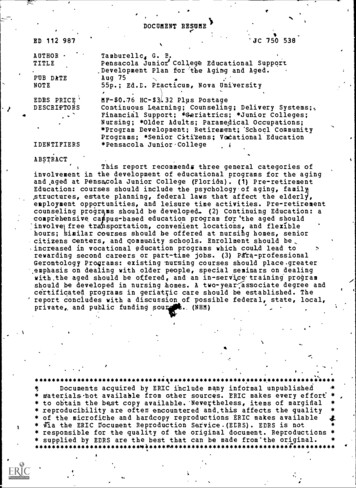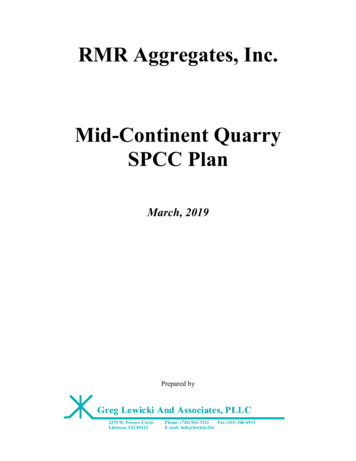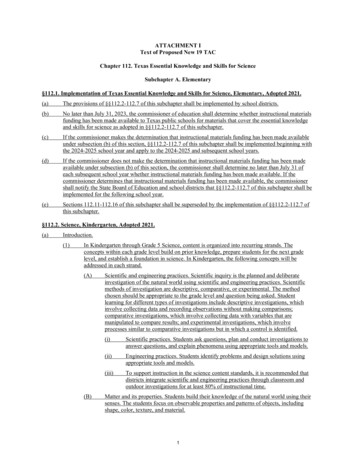
Transcription
.titiDOCUMENT RESUMEED 112 987AUTHORTITLE'LTC 750 538Tamburellc4 G. B.Pensacola JunioriCollegt Educational SupportDevelopment Plan for:the Aging and Aged.PUB DkTENOTEAug 75N*55p.; Ed.L. Ptacticum, Nova Uni'versityEDRS PRICE'DESCRIPTORSMF- 0.76 HC- 3 ,I.32 Pips Postage.'. 'IDENTIFIERS.Continuous Learning; Counseling; Delivery Systems;.,Financil Support; *Geriatrics; *Junior Colleges;Nursing; *Older Adults; Paramedical Occupations;*Program Development; Retirement; *Schocl CommunityPrograms; *Senior Citi'zens; Voeational Education*Pensacola Junior,College.4ABSTRACTtThis report recommends three general categories ofinvolvement in the development of educational programs for the agingandsaged at Pensacola Junior College (Florida). (1) Pre-retirementEducation: courses should include the psychology-of aging, familyi,structures, estate planning, federal laws that affect the elderlY,employment opportunities, and leisure time activities. Pre-retirementcounseling progr ms should be developed. (2) Continuing Education: acomprehensive ca pus-based education program fOr'the aged should'involve free ttai sportation, convenient locations, and flexiblehours;i.milar courses should be offered at nursing homes, seniorcitizens Centers, and community schools. Enrollment should be.increased in vocational education programs which could lead torewarding second careers or part-time jobs. (3) Para- professionalGerontology Programs: existing 'nursing courses should place.greater',emphasis on dealing with older people, special seminars on dealingwith ,the aged should be offered, and an in- service- training programshould be developed in nursing homes. A two-yearssociate degree andcertificated programs in geriatric care should be established. The' report concludes with a discussion of possible federal, state, local,(NHM)private, and public funding ********.****************Documents acquired by ERIC include owly infotmal unpublished* daterialsnot available from other sources. ERIC makes every effort ** to obtain the best copy available.'Neveytheless, items of marginal ** reproducibility are often encountered and.this affects the quality ** of the microfiche and hardcopy reproductions ERIC makes available* %Zia the ERIC Document Reproduction Service.(EERS). EDRS is not* responsible for the quality of the original document. Reproductions ** supplied by EDRS are the best that can be made from'the ****************,a**********.4,t
u' DE AR TmE NT OK NEAL TNiDOCATtON t wELF AQENATNYNAL INSTITUTE OFEDUCATIONBEEN kEPVN0.0C3MEN'Ex.:"vC( ( SON OkL.hPt; hkj. iN'DTS'LEO DC .C (OFF r1rt.h Ohl.ECi.E" 'F -;N4.,'PENSAC014-JUNIOR COLLEGEEDUCATIONAL SUPPORT, DEVELOPMENT PLAN' FOR'THEIAGING AND AGED4byG. B. Tamburello, M.A.Pensacola,Junior College.PREPARED FOR NOVA UNIVERSITYAugUst 1975E. d.32
,JI).S4PENSACOLA JUNIOR coLLEcr EDUCATIONAL SUPPORT DEVELOPMENT PUNYFOR THE AGING AND AGED1/ABSTRACTThe population of the aged over sixtY2five is Increasing rapidlyfrom its proportion of one but of ten to almost twenty percent by theend of the Century.This minority group, verlooked over the past yearp,41,etwill become a mote sizeable and potpnt polit cal, economic, and socialforce as wonder medicines, new surgifal teehni ues, more,gOvernment support.and a higher standard of living decrease the moality rate among"the aged.(,As the average life span ofAmericans increases pthe age of seventy,.and as birth rates decline, the proportion of older,- .ople will continueto Increase significantly.4 .14The educational and related needs of thesenfficant and must -be met.older4 people are, sigl;\Mos,t of the aged are not dried up sehile people/.incapable"of furthe? learning.t,On the contrary, their capabilities to.,absorb information never ceases, though it may be at a slo44r rate ofspeed./,',/A pre-retirement education program would help minimize the plemSthe aged face by becoming aware early of the physiological, psyholog cal,social, and financial problems they will face as they grow older.Theproper use oaf 1pisure time, so abundantly available later on in lif , mustbe stressed so that the aged can continue to lead.roductive and w rthwhile lives.4*The immediate educatfrom adult basic educatin 1 needs of the aged, on the conti uum, rangeto combat illiteracy, td cultural enr4chment.A3On
that same seale', there are also vocational educational requirements fbrthose who desire a second career or part time work.For those who are incapacitated in hospitals and nursing homes,fiteed.for paraprofessional personnel to be Ibetter trainedthere is a. cryinand educated in the needs and problems of the aged; for 'those still ambu.--latory, but limited in mobility due to lack of finances or transportation,.social educational services 'need to i% extended into the community.The responsihilityjor providing ighese educalional services mustbe shared by the school boards, community colleges and universities.Thecd5Munity college, however, appears to be the most comprehensive orgaAL,-zation capable of offering new and varied viable programs in concert withOle school; boards and universities.It seems to be emerging ass, the executiveagent, so to speak, for the development and implementationsof new commun4ty4ice programs,.The allocation of resources and funding for this new committment,which has already been accepted by many community colleges, may present aproblem.There are, however, sufficient federal, state, local govefnment,44.as well as private sourses.from which funds may be derived to develop theestablishment of new programs for the aged.If funds are not invested tomeet the needs of the elderly, the community will find itself expendingfunds anyay for, he care of unproductive u1and psycho4gical problems.appy people with many physical4111,44.Pensacola Junior College has 'a new challenge ahead in meeting the.above mentioned needs of a segment ofthepopulation which is'growing veryrapidly in Northwest'Florida.Tie College is certain to recognize its,responsibilities as it has dOne so well in the past twenty-seven years.r"'4
PENSACOLA JUNIOR COLLEGE EDUCATIOAL SUPPORT DEVELOPMENT PLANFOR THE AGING AND AGED,Chapter 1aIIntroductionPensacola Junior College rightfully considers itself a truecommu.lity odllege servin.,,,, the manyneeds of the community.The scopeati masnitude of its copmprehensive transfer,adult basic education andal)careeL development courses.pttest.to accomplishment of mission.Thebeen addressed to anyonly segment of the population whose needs have not -:ging and aged group.real degree is thePensacola Junior 'College, likeavoided the fulfillmany other colleges, has not premeditatedly shunned orment of the educational needs of these people.Though the problems of the/-.2aged have been recognized, their'needS have not been placed high on apriority list.iRecent support and recognition by thNedetal govenmentgroupand attendant publicity Of probleps of the aged have vaulted thatinto competitive' consideration.T4e no-growth enrollments many collegesandhave been 'exper4encing, provides an opportunity'to readjust priorities.resources to Meet the needs-of the expanding elderly population.EventhouF11.1201sacola.Junior College is still.experienclx growth factor ofapproximately 5-6% per year, Pensacola Junior College should bd able tCexpand into elderly education programs without serious prejudice to exist,Sfng pr%bams.'This study will address itself to thcLgeneral problems which facethe a7,in: and a:.,ed and tic,wPensacolaTunforJCaV become more involve]
AY2II:encompass mostin the development of viablj,pducational programs.which w.of the aging and aged.of the educationalThe recommended involvement/--(adult,includes pre-retirement, continuing educationttural enrichment,4.recreational," and social programs), as well as the trains of parapro- Nfessionals who deal with elderly in their'daily work.Further reconmenda-.tions are suggested as to how.Pens,Fola Junior,ColleCan serve as aprograMs.catalyst in comMunity services-aging and aged.I1IV.17
3Back-,poundAt op turn of the.Ceritury, 3.41% of the pdpulation, represent9iDy ]970 the total numbersby 3,000,000 people, were over 65 years of age.1In the'had increased to 20,000,000, 10Z of the total American population.past decad,d alone this age group increased by 22%'while the popution aged275 or older increased by'37.4.The increased longevity brobght upOn bythe miracle of drugs, bett r surgicaltechniques, lower birth rates and the1benefits 'f a higher standayd 'of living will inc'rea'se the "65 and over American-.3.If those 60 and over were to bepopulation to 29,000,000 by the year 2000.1.included with those 65 snd over, the percentage.wuld increase from 10 toThe impact of the ageOin Florida is aabout 15% of the total population.theNOW affair since Florida ranks #1 in the UnitedStStes wit4 15:5% of4v:).'total population aged 65 or older.President to4recognize the fdth- 'resident Truman was the first.,coming-problem of the old age population explosion by convening A Coierence.wt.on the Aging in 1950.'However, Congressional recognition and action did not/fundsmaterialize until the mid-fifties when it provided the legislation andfor President Eisenhower to convene a White house Conference on the Aging.1New,Facts About'Unit6d States Department of Health, Education and Velfa(SRS)73-20006,(Washington;D. C.:Older Americans, D PM Publication NoSuperintendent of Documents, United States Government Printing Office,June 1973), p. 2:21971 White House Conference on Ar.inc,, - Final Report (Vol.Health, Lducation and 1:elfare, 1971), p. 132.ton, D. C.:3IctS Ahout Ol&r Offirriolnl, Op Cit, p.4Ibid, p. 3.2.I), (Washino-V
.14That C9nference's recomepdations were the basis for the Medicare, Medicaid,ana Social Security benefits legislat ed in the 1960's and resulted in, thepassage of the Older American Act of 1965.In 1966, the passage of PublicLaw 90-526 set the stage fo't the Second Conference for the Aging which wasto be he.ld in 1971.to, assess.HoweverThe long-range effects of that Conference are too earlythe Older American Amendments of 1972, andvariousState Legislative actportend a greater emppasis on the problems of the agedin the very near future.Tlie problem areas normally associated with older Americans' include'4/housing, retirement, employment, nutrition, transportation, income, spiritug,,15well being and education.-.,:It is the latter problem and the interface withthe enter problems, with whiCh this study mainly will foncern itself.Therewere twenty-eight distinct recommendations in the Education Section Report.Nine recommendations pertain-Only to Nationalrand Stage agencies; however,the majority of the recommendatiors, were practical and worthy of considerationpy community colleges.The educational recommendations which are particularlypertinent are quoted below:Expansion of Adult Educational programs - The exjnsion ofadult educational programs having a demonstrated record ofsuccess should- receive higher priority with due considerationbeing given to experiNnlal and innovative programs.Educational Opportunities for all Older Persons - Educationalopportunities mutt be afforded all persons, with spetial effortsmade to reach those who because of row income, poor health,social circumstances, or ethnic status are less likely to respondvoluntarily. Outreach pregfats should use all appropriate charmersand delivery systems.wti45latite House Conference on .Aing, Op Cit, p. 26.\
5Eliminatrng Bnrrlers to Educationnl Services -,For older.persons to partic.,pate,in educational programs, agencies,Theseorganizatiops, and governlent must provide incentives.barriej\gincentives should be aimed at eliminating specificto the availability dnd accessibility of educational servicesfor older persons including transportation, free attendance,subsistence,,auditing privileges, relaxed admission requirements, flexible hours, conv'nient locations, subsidies- tosponsors, and removal of legal baTriers.Public Librarie"- A Community Learning Resource - Publiclibrfries solve to support the cultbral, informational andrecreational aspirations of all residents at many communitySince older adults are increasingly advocating andlevers.participating in lifetime education, we recommend that thepublic library, because of its nearby neighborhood character,be strengthened and used as a primary community resource4Adequate and specific funding for this purpose must be,forthcoming from all levels of government and, most important, fromprivate philanthropy.Use of Leisure'- Emphasis should be given at every level ofeducation to implement and expand the expressed educationalobjective of bworthy use of leisure." Education must bedirected toward an acceptance of the dignity and worth of nonwork pursuits as well as development of leisure skills andappreciations.Educational opportunitiesScope of Educational Ooportunitiesmust include basiC, continuing, vocational education and training about need§ifor better use of services, cultural enrichment,and more succenful adjustment to aging.Need as a Basis for Fundikg,- Available facilities, manpowerand funds must be used for educational programs designed andoffered on the l\sis obthe assessed needs and interests ofolder persons. The initiative may be taken by many sources, butthe design and curriculum must include active participation byolder persons.Toward a National Understanding of Aging - A national awarenesscampaign must be initiated through mass media and throdgh educational systems to promote better understanding by society ofthe nature of the aging process; the needs and interests of olderpeople, and the positive contributions and potentially untappedresources of older persons.rre-rotirpmwm ,Uqcation - Pre-retiremPut education programsmust he c-ztabli,lhed to help .thoqe nppronching,retirement age to,achieve greater satisfaction and fulfillment in later years.-0*
Pre,-retirekent education must be the primary vesponsibilityrofthe publib education sector in cooperation wi h relevantcommunity crganizations in the areas of Indu try, labor, alllevels of governthrmt, voluntary service, and private' associations.Inservice rducation for Professionals - 'e urge that institutions of hiy,her learning provide oppo tunities for specialprofessional preparation of those who wi], work and are workingwith older persons (law, medicine, ,social work, home.economicsirecreation, cdu,:ation, etc.). nore atte tiort must also be givento workvalon, institute , and inservice education for those whonow work with older adults."The recommendations can be pmpressed.into four general categories:pre-re,tirement education, continuing educational opportfties, courses.devoted to the training of persons interested in wog king with older people,,anfinancial suppoilt for the programs.As indicated earlier, Pensacola Junior College has been a leader inI1with the exception of the aging and aged, whose, needsmserving, the co,,,unityhave not been fulfilled because their needs have not been expreSsa orknown by the *College.' No detailed survey has ever b een compiled.Ifspecial programs were tobe offered to those 65,br over, it is certain thatmany more would be attending classes.In interviews. with directors of localnursing h mes, Council for Aging, community schools, there appear to be many-,opportunities for Pensacola.Junior College to assume'a leadership role inthe develapdentignd.implementation of special program§ for the elderly.The4contents1-1d results of those interviews will be referenced as each programof action is discussed:The question of when does one become old hat been debated, for centuries.For definition purposa, the difference between aging.and,aged is the processof getting old, which in these days yoUth considers to be the overthirty crowd.6Ibid, Vol. IT, pp. 2-8.10.0
7What age constitutes qualificatiOn.for.consideration to be included in theaged group varies.others OlandThere are those who consider 55 as agestill others 65.11The Cliliese say that between 60 and 70 a person is "19ng for age;"t,4at 70' he qualifies for old age.Pythagoras said old, age started at 60,Hippocrates said 56 and 63 was more inclusi:Vey the psychologist Flowersstated in the 19th Century there were two beginning periods, one at 69 andthe other at 85, the Polish anatomist Bochanenck stated that there were threeperiods of old age: 60, 70, and 80-90.11The.American Public Health Assoeial.tioh defines the period of"65-74 as the early period of old age and old as775 or older.There are those who are 75 and very young with all their facultieskrazor edge sharp:Then there) are those who are prematuy old, perhapsdue lto physical and mental impaitments.As the mortality rate decreases, amale who reaches his 65th birthday, can expect to live an average of 12:98more years, whereas a female can expert to Ave 15.9 years.'This me nst,)that many persops will be spehding 15-20 yeais in retirement: The pthat confrpnts educational institutions is twofold:blemS.one is to 'repare theaging for the day aged arrive6, the other to devise programs-for the agedsothat they can read productive and happylivedwhetheeit be for financial44,7Donald Cowgill, "The Demography of Aging," The Daily Needs and Interests ofOlder People, Adeline M. Hoffman, (Springfield, Illinois: Charles C. Thomas,1970), pp. 29, 30.81Arnold Pose, "Future Development in ,\,,in--Perspectives," The Daily Needs lndInterests of Older Peonle, Adeline M. Hoffman, (Springfield, Illinois:Charles C. Thothas, 1,270), p. 453r\
support or for effective leisure time utilizatiOn.In either situation,educators- nee4,ndt fear the capability of the older population to learn.StatiSticS show that learning-cap Willies slowdown with old\.age but itdoes, not stop.Researchshows that\intellectual power-remains essentially4,the s-ane throughout life;if the by in is kept alert and active, mental9powers will not decline,Therefore, according to'Thorndyke, Oweris, andMirza:nan, learning can take place ifovative, specially designed courses10are offered and there is a student desire to do so.Ati9Samuel E. Hand, "What it Means to Teach OlderlAdults," A Manual on Planninc:Educational Proprars, for Older.Adults, Andrew liendricksipn, Ed., (Tallaha,;bee:91973), p. 116./10 ,.,U. Lee Jacob; "Education for AAine,," The Daily Nee.O.s.and Interests of 01,7,rk4 nois:Charles C. Thomas, 1910),'''People, Adeline N. Hoffman, (Springfieldp. 453.(I12.
49Chapter 2Pre - Retirement F. -Cationproblems facing the aged might not have presented them-Many of/selves had the individuals concerned themselves with the inevitable eventIn the old days, little thought was given by the individualof growinE old.to' pre retirement planning since he worked until he made enough money tobecome financially independent or worked almost until he was physicallyspent or died,,on the job.During the 18th centvry, men died at the averager.1age bf 35; in the mid-4th Century, it was42 and now it is 70.,Until recently preoccupation.with making plans fc4r a pr6tracted1retirement life did.not exist.patterns.4NowFederal legislation ha'sSocial Security laws permit retirement as ea.ered retirementy.as 62, whileretirement from federal and state civil service positions can occur at age55.Military enlisted personnel may retire as early as 37, with officersThough private industry retire-retiring Odle they are in the mid-forties.went policies Nave not been as liberal or magnanimous, trends indicateta0ier retirement !plans wThe increasappear in the near future.in longevity of life coupled with earlya-etirements,provides opportunit es for second careers and better use of leisure time.,Certainly, thisbe filled.lonerlife.a p in time between retirement and death mustA Louis 1arris poll indicated that Americans who retire early,2do not desire to beC.n the shelf but would rather lead a different life.'1Herman J. Loether, The r rz,shlof Agin(,,(Beim/Alt, CaliforniaPublirhing CorTnny,1960, p. 106.2.Ibid, pp. 7'2-74.3Dickinson
.4.t1,''1111.With this thaught in mind and with the hip cost'of living, three-fdurthsq.'of the younger retirees expect to work again, with one-'third in full timer-Howev er, at the same time, the realities of the employmentemployment.situation must be considered, since the ratio of-workers to non-workersin-the aged population is dropping as adverAe economic conditions create.higher unemployment rates.Obsolescence of working skills, re location of'10,pnts and earlier forced retirements will certainly increase the competitionfor second career jobs forcing tore' and more of the aged to leisure time4-activities.Very few people retire gracefully and happily. ,However, retirementshock can be mitipted by 1:re-retirement planning, which is important to4the retirees whether they pltn to work in a second career or whether theyhtend to take aianlre of\the newly acquired leisure time.To be effec-tivb, such 'Manning should be staged earlier it life and not a month.prior to the day when the gold watch is presented and a pat on the backs,9*is given for a job well done for the previous years-of service.The pre-retirement education should serv6'to appriqe the expectedretirees that the United States has ayouth oriented sociy, that ourculture stresses youth and vigor, upward mobility or out-concepts, and thatthere will be physical, emotional -and psychological adjustments to be madeby each individual.The mobility and dispersion of family members, Cleating19.13Minna Field, The iood, the Family, and the Community, (New York:Uniyersity Press, 1972), pp. 44-46.Columbia4Robert V. rlemei(r, Ainand Tc!glire,(Not. York:1961), p. 47.144Oxford University Crk:-.
t't,el'4feelipgs of loneliness, inadequacy, add loss of worth furthor emplicate.t5.11vtdjustment.i,.It is iqortant that the aging begin' to understand ther,psyciology of aging and, what' to expect as tliey grow older.'six huhdredfifty retirees, who had gone to compan5Aspensored pre-retirement educationprogrZ.S, made significantly better adjustr.ents than those'ho did not&Thompson, Stfeet and fosa study indicated yhat those.attend the course.who retired voluntarily but with unfavorable retirement attitudes, weremore satisfied in retirement than thOe who were forced to retire, but had7favorable attitudes.Those who are seeking a second caxeer need to plan seVeral years inadvance of a retirement date so that.they will be prepared to offer a pro.spective employer a unique set of highly competitive qualifications.'Iftthe prospective retirees were to be satisfied with*their past experienceas their passport to future employment they will become disillusioned early.Insad, they need todraw down the shade on the window of theyt, as painful as it might be, and look ahead only at the porthole of the, new future.,Retirees, who are without ajcb or do not intend to wars, need toavoid an early coefrontation with reality by keeping occupied.Those whoasit around thinking of the past, foi- want of anything better to do, willonly invite unhappiness.5Certainlythey need not fall into ylie trap that-Gladys Engel Lang, Old1961), p. 47.in America, (New York:H. W. Wilson and Company,6Vbite Pow.c. Conference on :\c.in 7Minna Field, op. cit., p. 72.Vol. I, op. cit., p. 12.
.124Ceorve Bernard Shaw -aptly described as "perpetual leisure without beingbeol.ed up to the main procession of life is a good working' conditpn of8'hell."The proper use of 3b.isure tine will be a factor to be reckonedwith by the working and non working, retirees. 'Those who are Oorking willork weekshave more leisure tine as vacation periods increase and shorter\become more prevalent.Leisure time; which the retiree sought so avidly,certainly can become a bore once it becomes a full time asset unless it is9Used to.deriiepersonal satisfaction through creative activities.Self-directing, deceptive and social activity programs involving reading, sports,hobbies, mu taPpreciation, friendship groups and life-long educational'experiences u'll need to.mbe addressed in the development of eisure time10programs.'RecommendationPensacola Junior College Would develop and offer prd-retirementeducation courses triiprepaxe citizens for the future shock of becoming older.Such courses should include at least the psYchOlogylkol tng, physiologicalchanges that can be expected as one becomes older, futtyke family relationships and structures,, estate planning, federal laws that affect the elderly,employment opportunilities for second careers' and asart time empioynieht.,8H. Lee Jacobs, "education for Aging," Adeline MHoffman, op. cit., p. 389.9Fere-lt.E.Co:Tany,1-to Plan(I ?outon:Gulf PublifAin-()).10Robert J. HaviOurst, "Leisure of Aging," Charles C. Thomas, op. cit;,pp. 166-369.
135opportunities for older'citizens to participate in voluntary charitableand civic projects, as voll as use of leisure time activities.Shorterspecialty programs in each subject area would also be appropriate., Such aprogram could easily be'offered as part of the 7 O'clock Series on campusas well as at the community .schools in the district.11Mr. 11, liatho;TO- "andDr. N. Applegate, directorg of the,community schools of Escambia County andGulf Breeze respectively, agreed that su'h a programis needed and would beC.Their respective facilities should be consideredan asset to the comiunity.'for off campus pre- retirement educAtion programs sponsored by the JuniorCollege.411The Junior College Career Development Center, which has done somuch in such'a short 'period of time in counselling mainly pre-college andcollege students in careers, has the additional capability to develop preretirement counselling programs.Discussions with Mr. WileyGlement, theDirector of the. Carder Development Center,; indicadccOncurrence for the,need of such a prog am and a desire to prOvide a servicefifor' older adults;An outreach prograN,fufly publicized, would do much to preparethe future retiree to lead a more useful life.1 SRE-T1Lcould be employedas a pUbfic information vehicle, to apprist listeners on services that are.11,.l''Statement made by Mr. Boyce Hatboro, Director of Community Schools, FscamZia County, in a telephone interview, Pensacola, Flotida, July 16, 1974.I12Statement made by Mr. Wiley Clement, Director of Career Development Center,4Pensacola,Junior ColicTe, Pensacola, Florida, in a personal interview,July 6, 1974.I7
available to the aged, as well as a developer of special programs on topicsdealing Yfth the arA.Mr. Erie Snith, Diroctpr of the Station, stated tliathe re,alized the needs of the aged, which are becorfing more pronounCed, shoLild13be planned in futurograpming.19IIt13(.--Statement made by Mr. Eric Smith, Directorinterview, Ponsacola, Florida, July 15,97.f WSRE-TV, .in a peisonat4
15Chapter 3Educational RequirementsIt is aell known fact that Northwest Florida is becoming a favoritespot for retirement.Theghan6e or seasons% the blue water and moderate.14living costs are attracting retirees to this Area to add to the military retirees who have bc.on Mocking here for years to take advantage of the good.weather for all-year golfing, boating and fishing opportunities.Accordingto the Chambcr of Commerce, 90-100 local workers vho have just reti ed, havebeen applying for social security.b nefits each month, attesting to the increasing popularity, of this arear retir6ment purposes.That fige'wo04be even greater if newly arrived out of town retirees were to be in ludea.4,According to the 1970 census, is zeported by the Pensacola AreaChamber of Commerce, the wetired population was distributed as follows inEscambia and Santa Ross Countiesf'Esc ,bia (Population 205,334)TotalFemaleMaje60 -64 - 310365-74 - 362875 over Pensacola (Population 59,507).Male60-64TotalFemale'110165-74 - 137775 over 7613239.150122621340'1451034.2602363921014,2VII
Li160Santa Rosa (Population 37,741)Femn1AMale,60-6465-74-' 49768175 refore, the college district in 1970 had a total of 31,633 over1sixty years of age out of a total population,of 302,582,with almost fif-teen thousand over thk age of sixty-five yeJs.,0The recent explosion ofgrowth experienced by Northwest:Florida qince the 1976 census, will certainly"e aged.add its proportional shareHoweveTno statistics are available.i1.L'se older pe ple run the gamUt from adultThe educational ne1,-basic education to recreational,1',.,-,.tural enrichment, and social type progrws,Dr. McClushkey stated that "toelf-reliant, elderly steed more than craftclasses aid music appreciation cE;es to increase enjoyment in life,mustlearn to read and write.Man 91Other functions slow down, ability to learn. .(2remains constant."'here is primarily a growing body of knowledse thatindicates that ability to learn many-new kinds of things increases with agebut'"there is the same ability within older aut groups as with any other3group."A1.'1U. S. Department of Commerce Bureau of Census, 1970 Census of Population,.(Washington, D. C.: Government Printing Office, 1973).2Educational Report, "The Aged: Education-for- the Elderly," School atjdSociety, Vol. 100 ro. 2341, .(New York: Society for Advancement of EducationInc.; April 1972), pp. 212, 213.3An Overview," Andrew Uenrickson, A ManullopPlannin-,Thomas A.Rich, "AgiutDepartment of Adult' Educationnl Pro'zram,: for Oldct Adults, (fatlahassee:Education, Florida State ifiTivcrsity, 1973), p. 7.
ON.4Adult Basic EducationGreat tlridesohave;F,,en made o'er the past .few years, with federalfinancial assistance, to raise tha median grade level of oidetpeople.the last'twenty years the grade,;evel has risen,from 8.4 to.11.7.OverThis is0the goodnews. The bad news is that the ill.terate population amongthose.,p.65 and over is extremely high, with a ratioYet of all,f one out of five.the 479,91
PENSACOLA JUNIOR COLLEGE EDUCATIOAL SUPPORT DEVELOPMENT PLAN FOR THE AGING AND AGED. Introduction, Chapter 1. I. a. Pensacola Junior College rightfully considers itself a true. commu.lity odllege servin.,,,, the many. needs of the community. The scope. ati masnitude of its copmprehensive. transfer,adult basic education and. al).











